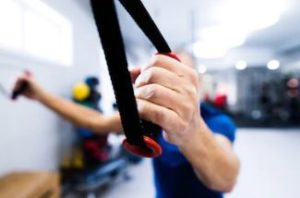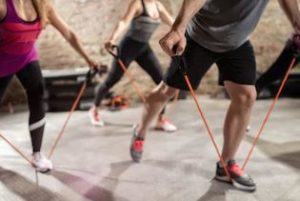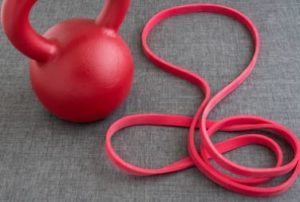There’s a single piece of equipment you’ll find in just about every physical therapy office around the world. It’s used to help patients build muscular strength and endurance, increase mobility, and ultimately recover from an injury or surgery.
Know what it is?
Anyone who’s ever had to rehab a shoulder, has probably used this for weeks, long before cranking out barbell shoulder press reps. But it’s not exclusively used by physical therapists.
You can use this same piece of equipment to workout when you don’t have access to weights. Or you can use it in the gym to turn a barbell or dumbbell workout into a serious strength training session.
It’s a resistance band. If you’ve spent time in the gym or physical therapy, you’ve probably seen these bands in a couple different styles: 
- Tubing with handles
- Flat-looped bands that look like giant rubber bands
Let’s assume you’re injury-free and plan to keep it that way. Can resistance bands still
help you build strength, muscle, and endurance? Absolutely.
3 reasons to train with resistance bands
If you’ve ever thought resistance bands were just for physical therapy, or the person who isn’t strong enough to lift a dumbbell, you’re not alone.
But there are at least two good reasons to train with resistance bands.
1. Make your muscles work harder.
Think about what a typical barbell curl looks like. You start with your arms extended and the bar hanging about mid-thigh. You slowly curl the bar up, forcing your biceps to contract. But the closer you get to the top of the rep, the easier the curl becomes.
Add a resistance band to your barbell curl, and it’s a game changer. As you curl the weight, you’re increasing tension on the band, and forcing your muscles to work harder.
2. Build strength
When your muscles are forced to work harder with each rep or contraction, you’re speeding up the process of fatiguing those muscles. You’re damaging muscle fibers in the process. And after a day of recovery, and possibly some muscle soreness, you’re just a little stronger.
3. Increase the mind-muscle connection
 In a study published in the Journal of Strength and Conditioning, researchers wanted to find out if training with resistance bands had any impact on performing barbell squats.[1]
In a study published in the Journal of Strength and Conditioning, researchers wanted to find out if training with resistance bands had any impact on performing barbell squats.[1]
In the first test, participants followed a typical warm-up plan with a couple lighter-load sets. But in a follow-up test, they warmed up using resistance bands. And something interesting happened. They were able to lift more weight, and set a one-rep max PR for squats.
“Variable resistance VR seems to potentiate the neuromuscular system to enhance subsequent maximal lifting performance,” says lead researcher Dr. Minas A. Mina, based in the United Kingdom.
“Athletes could thus use virtual resistance during warm-up routines to maximize squat performance.”
Can you use resistance bands as a stand-alone training tool?

Of course. Resistance bands can be a great way to warm up before lifting, and make those training sessions harder and more productive.
But you can also use resistance bands without weights, to build muscle, strength and endurance. If you’re ever in a situation where you don’t have access to a gym, resistance-band training can be a great alternative.
Out of town, on vacation, or can’t get to the gym? You can use a resistance band or resistance tubing with handles to perform exercises such as:
- Front Squats
- Bent-Over Rows
- Glute Bridges
- Push-Ups
- Reverse Crunches
- Bicep Curls
- Shoulder Press
- Leg Extensions and Curls
- Pullovers
- Bench Press
- Lateral Raises
- Triceps Extensions
Looking for more ways to train with resistance bands without weights? Check out the Resistance Bands for Muscle Strength guide published by the University of Arizona.
Resistance-band training with weights
If you want to use resistance bands while training with weights, it’s pretty easy. Pick the best anchor point for the resistance band based on the exercise you’re performing. Drop the weight of your typical load for a set. And give it a try. You can do this with almost any exercise. Four good ones to start with include:
– Barbell Squats
– Barbell Bench Press
– Barbell Deadlift
– Barbell Bicep Curls
Rules for resistance band training
Anybody can train with resistance bands without weights. Start with a lighter-tension band, and perform sets of 8 to 12 reps. Then move up to a band with more tension as you get stronger. It’s a great way to get started, if you’re new to strength training.
 If you want to use resistance bands to train with weights, start by using bands just to warm up without weights. Then work on improving your lifts (without bands). Aim to lift a little heavier from week to week. Improve your form. Then introduce resistance band training to help you keep making progress.
If you want to use resistance bands to train with weights, start by using bands just to warm up without weights. Then work on improving your lifts (without bands). Aim to lift a little heavier from week to week. Improve your form. Then introduce resistance band training to help you keep making progress.
When you’re training to shred fat, build muscle, or transform your body, your muscles respond best when you change up your workout routine periodically (every 4 to 8 weeks on average). Adding resistance bands to your warm-up, training when you can’t get to the gym, or to a weight training session can help reach your goals.
Have questions about using resistance bands? Let’s discuss on Facebook.
References
1. Mina, M.A., et al. (2014). Influence of variable resistance loading on subsequent free weight maximal back squat performance. Journal of Strength and Conditioning Research. From: https://www.ncbi.nlm.nih.gov/pubmed/24796978


